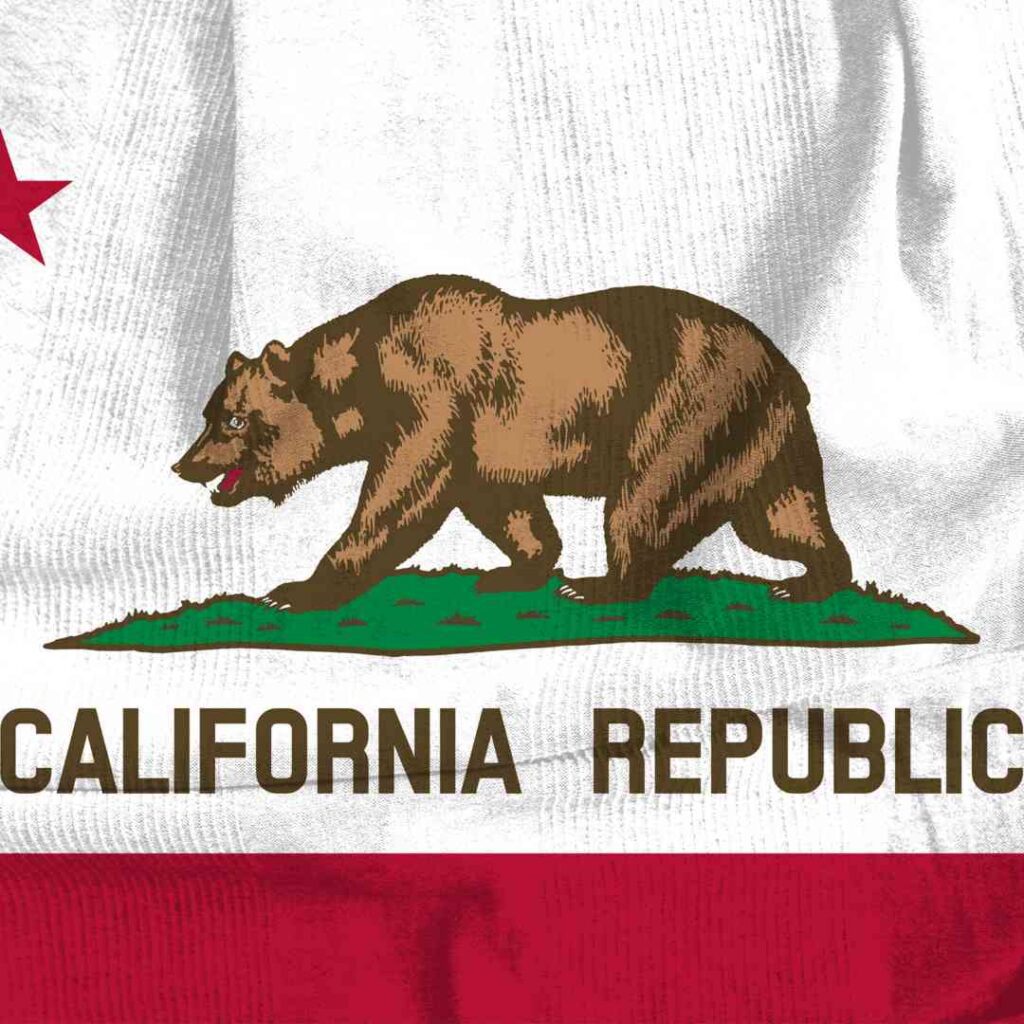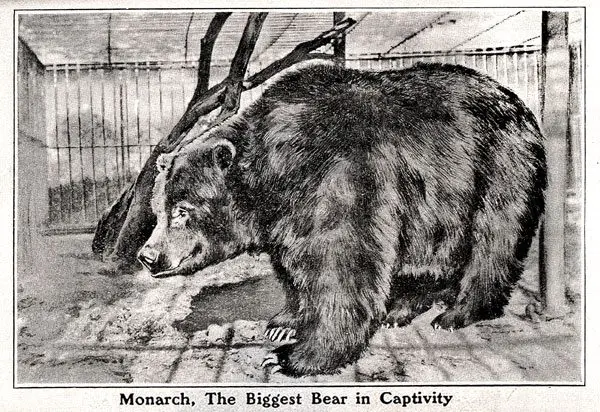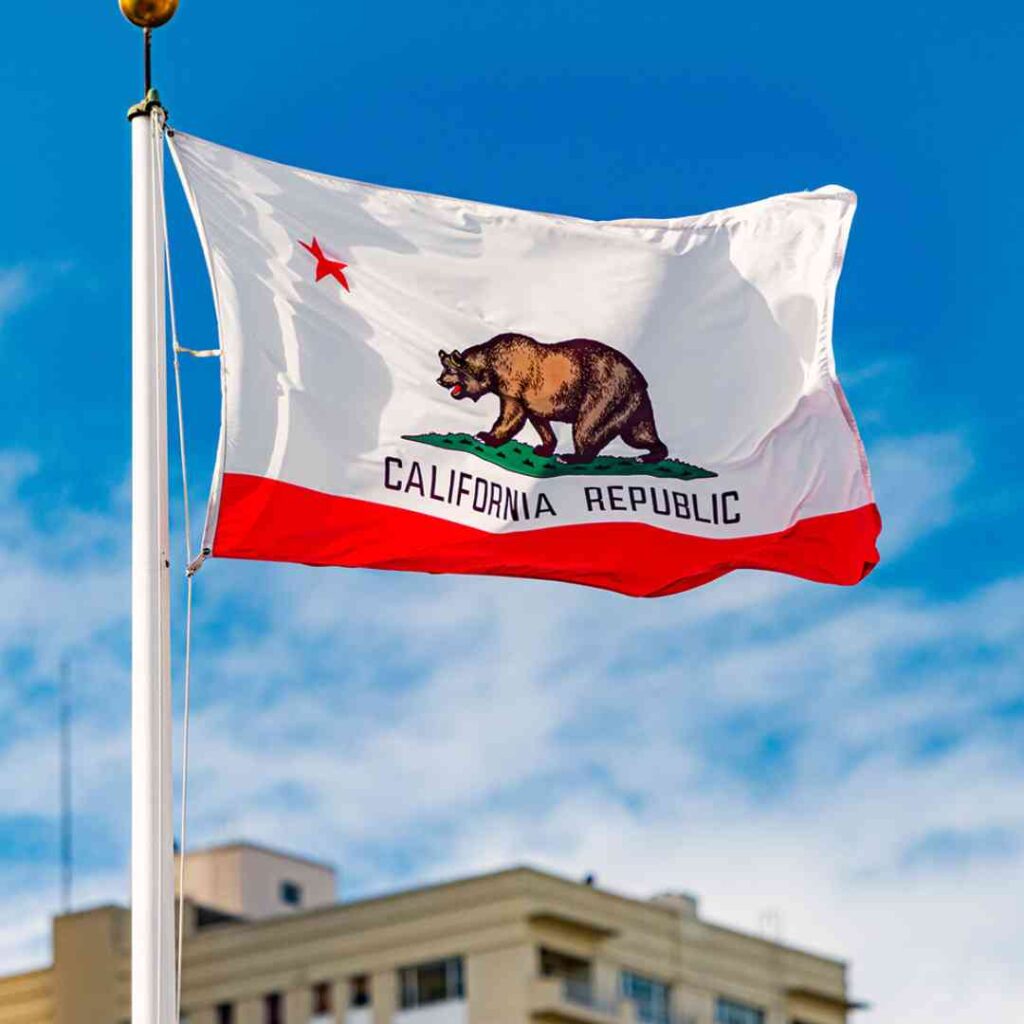Have you ever wondered why the California flag has a grizzly bear on it when Grizzly Bears have long been extinct in California? Like many things with California, the flag has a very flavorful past.
The California flag is a symbol of California’s heritage and history. At the heart of the flag is a grizzly bear, an animal once found abundantly within the State of California, but his sense has almost become extinct. The flag is based on the bear Monarch, who was kept in a cage in San Francisco for over 22 years. Today, there is some controversy over the California flag. Read on to discover more about the story behind California’s Bear Flag.
Table of Contents
- The California Flag With The Bear
- History Of The California Bear Flag
- Controversy Over The California Bear Flag
- Related Questions
The California Flag With The Bear

The California Bear Flag symbolizes California’s heritage and identity, which has seen tumultuous times throughout its history. At the heart of this flag is a California grizzly bear, an animal once found abundantly in California but has since become extinct in the State.
Also on the flag is a red star with the name California Republic. Like the State of California, the California flag has a colorful history and past.
History Of The California Bear Flag

For many people, the choice of a bear on the California flag looks pretty odd, especially as there are no grizzly bears in California.
The flag’s story started in 1846 when California was still officially a territory of Mexico. At the time, several Americans came to the Mexican-California territory.
During the same time, the famous California gold rush was also starting, and so many people were hearing about the gold that could be found in northern California. One group of American settlers in north California decided they would ban together and capture the city of Sonoma from the Mexican government and declare it independent and part of the United States.
The Republic of California was formed, but like any suitable republic, it needed a flag. So this group of settlers hastily made a banner with a red star, a red line, and a very crudely drawn animal that was supposed to be a grizzly bear.
The people who designed this original flag were not artists. They were ranchers, adventurers, and farmers. At the time, grizzly bears were quite common in California. Many of these first settlers said you could not ride a mile on a horse without seeing a grizzly bear.
They also knew that the grizzly bear could be dangerous, so they placed it on the flag. The grizzly bear they felt would help scare away the Mexican authorities and let them know they were serious about their independence from Mexico.
This independence was short-lived; it was not until 1850 that California was officially declared a state of the United States. As the population of California continued to grow, the grizzly bear population of California began to decline rapidly.
The Story Of The Grizzly Bear Monarch And The California State Flag
In 1889, William Hearst, the newspaper mogul, wanted to bring the grizzly bear back into the spotlight of California. As a publicity stunt, he tried to bring a California grizzly bear to San Francisco so it could be put on view for everyone to see.

So William Hurst sent one of his journalists, Allen Kelly, out to find a grizzly bear. But the problem was that Alan Kelly had no hunting experience, and we don’t even know if he had ever seen a grizzly bear.
Allen Kelly spent months trying to find a grizzly bear. He hired many people, and he fired many people. . He had several close calls and almost found one, but it was not until he was able to hire a group of Mexican hunters that they helped him to find the grizzly bear he needed.
The bear was captured and taken to Golden Gate Park, where he was displayed. The California Grizzly Bear was given the name of Monarch. Monarch was a huge grizzly bear weighing 1200 pounds and the biggest grizzly bear ever held captive.
Monarch arrived in the city of San Francisco with quite a fanfare. At least 20,000 people showed up for his arrival and to see this mammoth of a grizzly bear.
Monarch had a tragic life in captivity. He lived in a concrete cage for over 22 years. In his later years, many felt that he looked gloomy and miserable.
Allen Kelly, who captured the Monarch, would many times go to see the Monarch in his cage and apologize to him. He said he would tell Monarch how much he regretted capturing him, placing him in a cage, and bringing him out of the wild.

Listen To Our Podcast About What Does The California Flag With The Bear Mean? below or by clicking here.
A New California Flag Was Adopted In 1911

Monarch, the grizzly bear, died in 1911, and his body was taken to the Berkeley Museum of Vertebrates Zoology. His pelt was stuffed and displayed at the California Academy of Sciences the same year California was to adopt a new state flag.
Californians decided to take their queue from the revolt of 1846 and adopt a flag similar to that original revolt. California decided to make the California grizzly bear the flag’s focal point. Only this time, they wanted a bear that looked like a bear, not the crude sketch the original settlers had made.
The illustrators for the present California flag use the body of the deceased Monarch as a model for the bear on the California state flag. Monarch has forever been immortalized on the California state flag.
Controversy Over The California Bear Flag

The California Bear Flag has been the subject of much controversy over the years, mainly due to its depiction of a bear that is no longer present in California. In addition, some have argued that the flag glorifies California’s violent past and that it should no longer be used as California’s official flag.
Add to this is also the controversy that Monarch the Grizzly Bear, a model for the California state flag, was held inhumanely in a cage for over 22 years.
Despite this, the California Bear Flag remains a powerful symbol of California’s independence and California pride. It is essential to remember that while the California Bear Flag may not speak to everyone, it can still serve as an important reminder of California’s past and its diverse history.
At A Bus On A Dusty Road, we talk about travel, life, and ex-pat living. We are all about “Living Life As A Global Citizen.” We explore social, cultural, and economic issues and travel.
We would love to have you be part of our community. Sign up for our newsletter to keep up-to-date by clicking here. If you have any questions, you can contact me, Anita, by clicking here.
Listen to our Podcast called Dusty Roads. You can find it on all major podcast platforms. Try out listening to one of our podcasts by clicking here.
Subscribe to our A Bus On A Dusty Road YouTube Channel with great videos and information by clicking here.
Related Questions
Is Yogi Bear’s Jellystone Park Based On Yellowstone Park?
Yogi Bear’s Jellystone is known to be based in Yellowstone National Park, even though it is supposed to represent all U.S. National Parks. Yogi Bear is a fictional cartoon character that has been around since 1958 but has recently seen some reemergence with a new Yogi Bear Movie (2010) and Jellystone Cartoon series (2021).
You can read our blog on Is Yogi Bear’s Jellystone Park Based On Yellowstone Park? by clicking here to learn more.
Why Do Some People Call Themselves Ex-pats And Not Immigrants?
An ex-pat is an individual who goes overseas to work in a foreign country for a specific period. An ex-pat will remain a citizen of their home country; they do not intend to become citizens of the country where they live. On the other hand, an immigrant goes to another country to live permanently and not return to their home country.
You can discover more by reading our blog, Why Do Some People Call Themselves Ex-pats And Not Immigrants?, by clicking here.
Why Is Family History Important? 11 Reasons Why
Family history is important because it can help us connect to our living and dead family. It gives us a core identity of who we are. Family histories can teach us about perseverance, forgiveness, love, heartache, compassion, and sacrifice. Our family histories also teach us about humanity and help us discover faith and God.
By clicking here, you can discover more by reading our blog, Why Is Family History Important? 11 Reasons Why.


